Abstract
This paper studied the composite action of concrete-filled circular aluminum alloy tubular (CFCAT) stub columns under axial compression. A fine-meshed finite three-dimensional (3D) solid element model making use of a tri-axial plastic-damage constitutive model of concrete and elastoplastic constitutive model of aluminum alloy was established. A parametric study utilizing the verified finite element (FE) model was carried out and the analytical results were exploited to investigate the composite actions of concrete-filled circular aluminum alloy tubular stub columns subjected axial compression. Compared with the concrete-filled steel tube (CFCST) stub columns, the aluminum alloy tube exerted a weaker constraint effect on the infilled concrete due to its lower elastic modulus. Based on the FE analytical results and regression method, the composite action model of concrete-filled circular aluminum alloy tubular stub columns was proposed. By generalizing the stress nephogram of the concrete-filled circular aluminum alloy tubular stub column at the limit state, a design formula was proposed to estimate the ultimate bearing capacity the columns using the superposition method. The predicted results of the proposed formula show a good agreement with both the experimental and FE analytical results. The comparison between the proposed formula and current design methods indicates that the proposed formula is more accurate and convenient to use.
1. Introduction
Aluminum alloy has been gradually used in building structures because of its merits of lightweight, lustrous appearance, good corrosion resistance, good processing performance and easy regeneration as utilized in the Inter-America Exhibition Center of San Paulo (Brazil), the International Congress Centre of Rio de Janeiro (Brazil), the Sport Hall of Quito (Ecuador), the Memorial Pyramid in La Baie (Canada), the Shanghai Botanical Garden Exhibition Greenhouse (China) and the Zero Magnetic Laboratory of Beijing Aerospace Experimental Research Center (China) [1,2,3]. On the other hand, the aluminum alloy has a lower Young’s modulus (about one-third compared with carbon steel), yield and ultimate strength compared with carbon steel, which results in a lower bearing capacity and larger deformation when at sustain load that has hindered its ulterior promotion in the engineering practice. To make full use of its advantages and avoid its defects, researchers have recently put forward a concept of using aluminum alloy tubes as a substitution of the steel tubes in concrete-filled steel tubular columns (CFST) that has gained wide attention in the scientific community [4,5,6,7,8,9,10]. Extensive studies on the mechanical behaviors of CFST have been carried out both theoretically and experimentally [11,12,13]. Regarding the axial bearing capacity concerned in this paper, the confinement provided by the outer steel tube considerably improved the mechanical behaviors of the infilled concrete by delaying the crush and cracks, while the inward local buckling of steel tubes was prevented by the infilled concrete [14]. Such beneficial interactions under compressive loads in the CFST columns were expected and also exist in the concrete-filled aluminum alloy tubular (CFAT) columns, so the performance of the aluminum alloy tube is upgraded.
Since the mechanical properties of aluminum alloy are somehow different from the carbon steel, specialized studies on the axially loaded behaviors of CFAT columns have been conducted by various researchers [6,7,8,15,16]. Although it is still insufficient compared with CFST columns related research, some consensus has been reached by the scientific community such as on its excellent load-carrying capacity. For instance, a series of tests have been accomplished by Feng Zhou and Ben Young [6,7,8] and the ultimate bearing capacity, failure modes and the load-shortening curves of the square, rectangular [6], circular [7] and double-skin [8] CFAT stub columns were investigated. While the reliability of the American specification is known [17,18], the Australian and New Zealand standards [19,20] were also evaluated against the test results and the predicted strength of square and rectangular columns using current design codes were considered unconservative. On the basis of the aforementioned experimental study, a parametric study of concrete-filled circular aluminum alloy tubular (CFCAT) columns subjected to the axial load using a numerical approach was carried out [21,22] and a design equation with higher accuracy than current design codes was proposed. KZ Nasser [15] conducted axial compression tests of 24 CFCAT stub columns specimens as well and the influence of diameters, diameter-to-thickness ratio and slenderness ratio on the columns bearing capacity were discussed. In addition, a test of lightweight aggregate concrete-filled aluminum alloy tube was performed by Resan [16]. It was found that the combination of aluminum alloy tube and lightweight aggregate concrete can provide a remarkable high strength-to-weight ratio in the specific structural members. The existing experimental studies indicated that the axially loaded behaviors of CFAT stub columns are similar to that of conventional CFST stub columns. To further discuss the mechanism of composite interaction in the axial loaded CFAT columns, numerical study, especially the fine finite element (FE) model analysis was presented by a small number of scholars [22,23,24,25,26]. For example, Wang et al. [22] established a fine-meshed FE model utilizing the general software ABAQUS [23] with the consideration of the interaction between the aluminum alloy tube and infilled concrete. The multi-stress condition of the aluminum alloy tube was analyzed and parametric study based on the established model was conducted. Similar investigations were performed by other researchers including Zhao et al. [24], Idan [25] and Patel et al. [26] as well. To sum up, the aforementioned numerical studies are mainly focused on the discussion of the factors which affect the mechanical behaviors of CFAT columns under axial compression, but the investigations on the confinement effect and the composite action between the aluminum alloy tube and infilled concrete is still inadequate, and there is no specialized numerical model of the composite action of CFCAT columns has been reported.
The existing studies partially addressed the mechanical behaviors of CFAT stub columns under axial loading and supported its prospect of engineering application. However, more in-depth investigations are needed to thoroughly explain the difference between the confinement effect in the CFST and CFAT columns and to reflect this impact in the design formulas. In the meantime, the promotion of CFAT columns usage in structural engineering requires practical, simple yet accurate design tools. However, up to now, the specific calculation method of ultimate bearing capacity of CFAT columns is still rare and their derivation is very complicated or without clear physical meanings.
Hence, the main purpose of the presented study is to numerically evaluate the discrepancy of the composite action in CFCST and CFCAT stub columns and to propose an accurate yet concise design formula of axial bearing capacity of CFCAT stub columns. The main contents of this paper include: (1) A 3D FE model of CFCAT stub columns under axial compression was established making use of the tri-axial plastic-damage constitutive model of confined concrete and the elastoplastic constitutive model of the aluminum alloy. The validity of the established FE model was verified against the collected test results. Then, the non-linear FE analysis was carried out to simulate the entire axial loading process of CFCAT stub columns. (2) A parametric study was performed, the difference of composite action between the CFCAT stub columns and CFCST stub columns were discussed. A composite action model of CFCAT stub columns was proposed. (3) A concise design formula incorporating an enhancement factor considering the equilibrium conditions in the ultimate state was derived. The proposed composite action model was utilized to derivate the design formula. The proposed formula was assessed more accurate and concise than the existing design formulas.
This paper is organized as follows. CFCAT stub columns FE modeling, the selecting of constitutive models and the model validation are presented in Section 2. The numerical investigation of CFCAT stub columns subjected axial loading and the influence is presented in Section 3. Section 4 simply introduces the composite action model of CFCAT stub columns. Section 5 presents the practical design formula for axial load-bearing capacity of CFCAT stub columns.
2. FE Model of CFCAT Stub Columns
2.1. Modeling of CFCAT Stub Columns
2.1.1. Mesh Size and Element Type
The 3D FE model of CFCAT stub column was established utilizing finite element analysis software ABAQUS version 6.14 [23]. The 8-node reduced integral format 3D solid element (C3D8R) was applied to simulate the aluminum alloy tube, infilled concrete and the loading plate. The structured meshing technique available in the ABAQUS was adopted and a convergence check of mesh size was conducted to ensure the accuracy and efficiency of performed numerical study. The mesh size suggested by Zhou and Young [21] that the length-to-width-to-depth ratio of each element around 1:1:1 was reported rational and effective and was adopted in this study. According to Liu [27], considering the accuracy of the prediction results and the computation time of the model, the mesh size of D/10 is rational for FE models, where D is the outside diameter of the aluminum alloy tube. The typical meshed size of the entire model is shown in Figure 1.
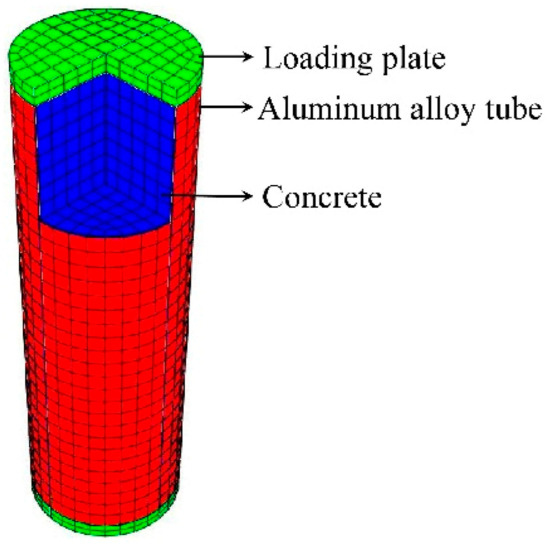
Figure 1.
FE model of CFCAT stub column.
2.1.2. Loading and Boundary Conditions
The axial load was applied at the center of the loading plate in the manner of displacement control on the top to simulate the axial loading process. The bottom ends of the stub columns were fixed against all degrees of freedom, the top end of the stub columns were fixed three directions of rotation and two horizontal directions of displacement while releasing the vertical displacement, as shown in Figure 2. Both material and geometric nonlinearities were taken into consideration and were solved by the incremental iteration method.
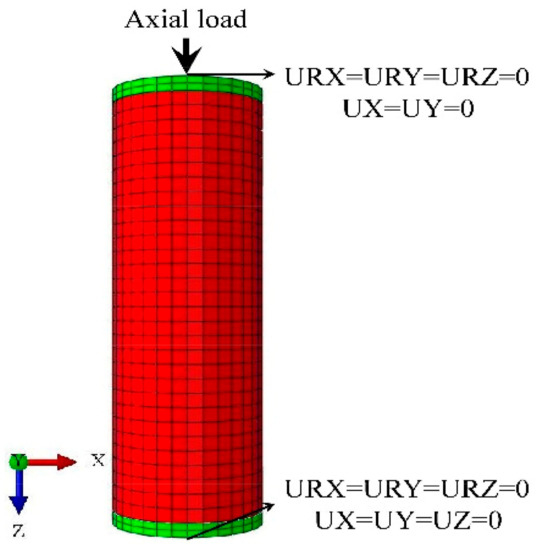
Figure 2.
Boundary conditions of the FE models.
2.1.3. Interaction of the Aluminum Alloy Tubes and the Infilled Concrete
The surface-to-surface contact pairs were adopted for the interaction between the aluminum alloy tube and the infilled concrete. The inner surface of the aluminum alloy tube was selected as the salve surface and the external surface of infilled concrete was chosen as the master surface [21]. Limited-slip was selected in the sliding formulation while the discretization method was surface-to-surface. The tangential behavior and normal behavior of the contact pair were defined as the contact property, while the penalty function was applied to the friction formula for the tangential behavior, in which the friction coefficient was 0.25 [21]. The normal behavior was set to “hard” contact which allowed separation after the occurrence of contact. The connection between the top surfaces of the aluminum alloy tube, core concrete and the bottom surface of the loading plate were tie connection while the nodes on the loading plate were adopted as the master nodes. This is to make sure that the axial load was simultaneously applied to the aluminum tube and the infilled concrete during the entire test progress. The deformation of the loading plate was assumed small enough thereby can be neglected and therefore was simulated by the rigid body element with the elastic modulus of 1 × 1012 MPa and the Poisson’s ratio of 1 × 10−7.
2.2. Constitutive Models of Infilled Concrete
The concrete damage plasticity (CDP) model has the ability to simulate a large number of quasi-brittle materials [28,29].
A tri-axial plastic-damage constitutive model of concrete under axial compression proposed by Ding et al. [30] was adopted in the presented numerical study. The uniaxial strain–stress relation of infilled concrete can be expressed as:
where y = σ/fc and x = ε/εc are the stress and strain ratios of the infilled concrete under the uniaxial compression, respectively. σ and ε are the stress and the strain of the infilled concrete. fc = 0.4fcu7/6 is the uniaxial compressive strength of concrete [30], where fcu stands for the concrete cube compressive stress. εc is the strain corresponding with the peak compressive stress of concrete, εc = 383 fcu7/18 × 10−6. A represents the ratio of the initial tangent modulus to the secant modulus at peak stress, A = 9.1 fcu−4/9. B = 1.6 (A − 1)2 is a parameter that controls the decrease in the elastic modulus along the ascending branch of the axial stress–strain relationship. When the steel ratio is more than 2%, parameter α is taken as 0.15 according to the previous study [30].
The tri-axial plastic-damage behaviors of infilled concrete was defined using the concrete damage plasticity (CDP) model: the eccentricity is taken as 0.1, the ratio of the initial equibiaxial compressive yield stress to the initial uniaxial compressive yield stress (fb0/fc0)is 1.225, the ratio of the second stress invariant on the tensile meridian to that on the compressive meridian is 2/3 [31], the viscosity parameter is 0.005, and the dilation angle is 40°. The abovementioned constitutive plastic-damage model of infilled concrete has been verified in the previous study of various sections of CFST stub columns under axial compression [30]. The constitutive model is not depend on the shape and material of the metal tube filled [32], therefore is applicable to simulate the CFCAT stub columns subjected axial compression.
The conversion formula of concrete cylinder strength fc’ and concrete cube strength fcu used in the analysis of collected stub column specimens are taken as [33]:
2.3. Constitutive Models of Aluminum Alloy Tube
Referring to Gardner and Ashraf [34], the expression of the stress–strain relation of the aluminum alloy is taken as:
where E0 is the elastic modulus, E0.2 is the tangent stiffness at the 0.2% proof stress; σ0.2 and σ1.0 are the 0.2% and 1% proof stress of the aluminum alloy, respectively. The ratio σ1.0/σ0.2 is taken as 1.08 for T4 temper material and 1.04 for the T6 and T7 tempers [34]. n and n’0.2,1.0 are the strain hardening exponents, n’0.2,1.0 is taken as 4.5 [34]. ε0.2 is the strain at σ0.2. According to Eurocode 9 [35], E0 of the aluminum alloy is taken as 70Gpa, Poisson’s ratio ν is taken as 0.3. The nominal stress–strain curves above are converted to the true stress-log plastic strain which is applicable for FE modeling analysis [36]:
where σtrue and σnom are the true stress and nominal stress of the aluminum alloy tubes, respectively. εnom and εlnpl are the nominal strain and log plastic strain, respectively.
As a comparison, an elastoplastic model, considering Von Mises yield criteria, the Prandtl–Reuss flow rule and isotropic strain hardening, was utilized to describe the constitutive relation of low carbon steel. The stress–strain relationship of steel [30] is:
where fy and fu (fu = 1.5fy) are the yield and ultimate strength of steel, respectively. E0 of steel is taken as 210Gpa. εy, εst, εu are the yield strain, hardening strain and ultimate strain of steel, respectively, in which εu = εst + 0.5fy/ζE0, εst = 12εy, εu = 120εy, ζ = 1/216.
Figure 3 shows the stress–strain relationship curves of the aluminum alloy and structural steel when their yield strengths are both 240MPa. It can be seen that the elastic modulus of the aluminum alloy is smaller than that of steel and there is no obvious yield platform as well.
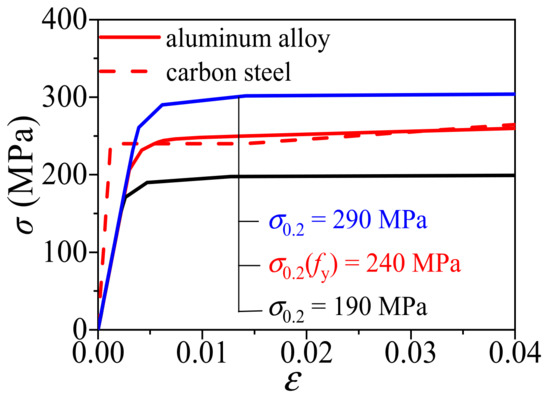
Figure 3.
Comparison of the constitutive relationship between aluminum alloy and carbon steel.
2.4. Geometric Imperfection
The geometric imperfection effect was considered the non-linear numerical simulation of CFCAT stub columns under the compressive loading. The linear perturbation buckling analysis method is used to consider the elastic material properties of the aluminum alloy tubes separately. Firstly, a compressive displacement load (1 mm) is applied to the top of the aluminum alloy tube (model A), the eigenvalue buckling analysis is performed and the first mode is extracted. Secondly, model A is copied to model B, take the first mode of model A as the initial geometric imperfection of model B. The overall initial geometric imperfection factor is usually taken as 1/1000 of the length of the component. Finally, model B considers the overall initial geometric imperfection, and the compressive behavior analysis can be performed.
Residual stress appears in the aluminum alloy tubes on account of welding. The residual stress in the aluminum alloy section causes the initial stiffness of the whole columns to decrease slightly [37,38]. After irrigating concrete into the aluminum alloy tubes, the effect of residual stress is further reduced [39,40], which is negligible on the overall behavior of CFCAT. Consequently, the effect of residual stress was not taken into account in the finite element analysis.
2.5. Model Validation
The FE models of CFCAT stub columns under axial compression were verified against the experimental result presented by Zhou and Young [7] and Gong [41]. The ultimate bearing capacity calculated by the FE analysis and the experimental results were compared in Table 1. The average value of the ratios (Nu,exp/Nu,FE) is 0.996 and the coefficient of variation (COV) was 0.073. Meanwhile, the typical load–strain curves of FE simulation and the tests results were presented in Figure 4. It should be noticed here that the displacement of the specimen LV100-2 in Figure 4c was reported to be measured from the ends of the test machine which results in a small stiffness. To sum up, according to Table 1 and Figure 4, a generally good agreement was achieved between the FE analysis and the test results, especially for the prediction of ultimate bearing capacity. Figure 5 shows the comparison of the experimental and FE analysis failure modes. Thus, the established FE models can be utilized to carry out the further parametric study of the composite actions.

Table 1.
Comparison of collected test results and FE analysis results.

Figure 4.
Comparison of FE and experimental load–strain curves: (a) test failure mode [7]; (b) aluminum failure mode; (c) infilled-concrete failure mode.
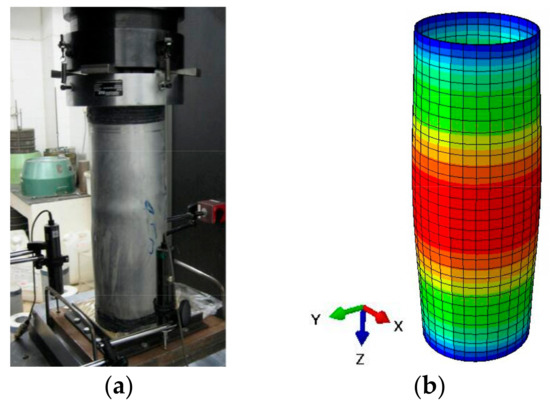
Figure 5.
Comparison of experimental and FE models: (a) test failure mode [7]; (b) aluminum alloy tube failure mode.
3. Numerical Investigation of CFCAT Stub Columns Subjected Axial Loading
3.1. Parametric Study
Based on the validated FE modeling approach, full-scale FE models were established to further investigate the mechanical behaviors of CFCAT stub columns under axial compression. The parameters analyzed herein were taken as: the constant diameter of D = 500 mm and the length of columns L = 1500 mm; the thickness of the aluminum alloy tube was taken as a variable of t = 5 mm, 10 mm, 15 mm, respectively and the aluminum ratios ρ range from 3.96% to 11.64%; the yielding strength of the aluminum alloy σ0.2 is 190 MPa, 240 MPa and 290 MPa respectively, while the concrete strength ranged from 40 MPa to 100 MPa. The temper of the aluminum alloy was taken as T4 uniformly. The strength of the aluminum alloy tube and the infilled concrete were paired according to the practical engineering application of the CFCAT stub columns: σ0.2 = 190 MPa was matched to fcu = 40 MPa and 60 MPa, σ0.2 = 240 MPa was matched to fcu = 60 MPa and 80 MPa, σ0.2 = 290 MPa was matched to fcu = 80 MPa and 100 MPa. The parameters of established CFCAT stub column models were summarized in the Table 2. Where n is the strain-hardening exponent reflecting the degree of strain hardening of the aluminum alloy. The value of n was within a range from 23 to 31 according to Eurocode 9 [35]. Additionally, a FE model of CFCAT stub columns with E0 = 210 GPa was established as well for the comparison of CFCAT and CFCST stub columns.

Table 2.
Material and geometric properties of specimens for FE parametric study.
The typical N-εL curves obtained from the numerical study were presented in Figure 6. As shown in Figure 6a, when fcu was increased from 60 MPa to 80 MPa, the ultimate bearing capacity of CFCAT stub columns was increased by 73.1%. And the stiffness of the specimen increased whereas the ductility decreased. Shown in Figure 6b, when σ0.2 increased from 190 MPa to 240 MPa, the ultimate bearing capacity was increased by 3.6%. The Figure 6c shows that when ρ increased from 3.96% to 7.84% and 11.64%, the ultimate bearing capacity was increased by 21% and 36%, respectively. When E0 increased from 70 GPa to 210 GPa, the ultimate bearing capacity was increased by 2% and elastic stiffness increased by 13%. Meanwhile, the ultimate bearing capacity almost unchanged when n ranged from 23 to 31, which revealed that the strain hardening exponent n has no considerable influence on the ultimate bearing capacity of CFCAT stub columns.
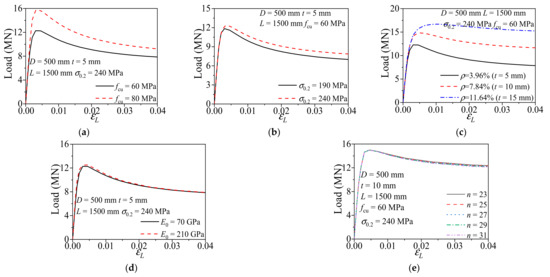
Figure 6.
Influence of parameters on the ultimate bearing capacity: (a) concrete strength; (b) yielding strength; (c) steel ratio; (d) elastic modulus; (e) strain hardening exponent.
3.2. Composite Action of CFCAT Stub Columns
The composite action between aluminum alloy tube and infilled concrete determines the mechanical behaviors of the CFCAT stub columns. Under axial compression, the infilled concrete is confined by the aluminum alloy tube while the tube is enhanced by the infilled concrete as well. From this point of view, the performance of composite columns cannot be only evaluated by the confinement effect exerted by the outer tube (the in-filled concrete expands under compression, and the outer aluminum alloy tubes limit its expansion), the enhancement effect provided by the infilled concrete should be considered either. Only in this way, the compatibility of two components can be evaluated reasonably. To this end, the following indicators were introduced here to explain how the composite action in CFCAT stub columns vary as the changes of design parameters. The radial stress of infilled concrete indicates the lateral compressive stress provided by the aluminum alloy tube on the infilled concrete, the enhancement effect of the infilled concrete can be evaluated by both the axial stress–strain and transverse stress–strain curves of the aluminum alloy tube. In particular, the earlier the axial stress–strain curve intersects with the transverse stress–strain curve, the better the enhancement effect provided by the infilled concrete. These indicators were employed in this study to evaluate the composite action of CFCAT stub columns subjected to axial compression.
3.2.1. Concrete Strength
Figure 7 shows the influence of concrete strength (fcu) on the composite action of CFCAT stub columns. As shown in the figure, the radial stress of concrete, the amplitude and rate of axial stress and transverse stress of aluminum alloy tube increased with the increase of the fcu. On the other hand, the intersection points of the axial stress–strain curve and transverse stress–strain curve of the aluminum alloy tube of different specimens almost coincide. A conclusion can be drawn here that the higher fcu results in a stronger confinement effect in the CFCAT stub columns while no considerable influence on the enhancement.
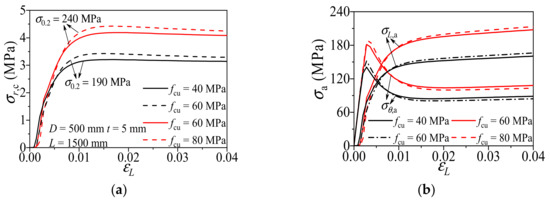
Figure 7.
Effect of concrete strength on composite action of CFCAT stub columns: (a) radial stress of concrete-axial strain curves; (b) stress of aluminum alloy–axial strain curves.
3.2.2. Yielding Strength of Aluminum Alloy
Figure 8 shows the influence of the yielding strength of aluminum alloy (σ0.2) on the composite action of CFCAT specimens. As shown in the figure, the radial stress of concrete increased as the σ0.2 increased. There is no significant difference in the amplitude and rate of axial stress, but the rate of transverse stress increased rapidly as the increase of σ0.2. As revealed by those comparisons, the confinement effect was strengthened with the increasement of the yielding strength of the aluminum alloy and the enhancement form infilled concrete was weakened.
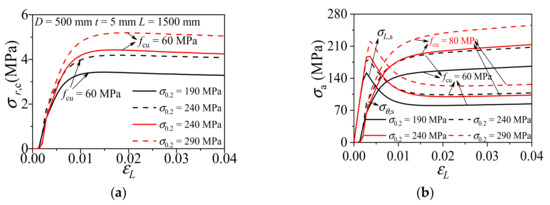
Figure 8.
Effect of aluminum alloy yield strength on the composite action of CFCAT stub columns. (a) Radial stress of concrete-axial strain curves; (b) stress of aluminum alloy–axial strain curves.
3.2.3. Aluminum Ratio
Figure 9 shows the influence of aluminum ratio (ρ) on the composite action of CFCAT specimens. With the same diameter, the numerical results show that the radial stress of concrete increased with the larger aluminum ratio. The intersection point of the axial stress–axial strain curve and transverse stress–axial strain curve was delayed as the increment of aluminum ratio. Hence, the confinement of aluminum alloy tube was strengthened and the enhancement of aluminum alloy tube on core concrete was weakened with the increase of steel ratio.
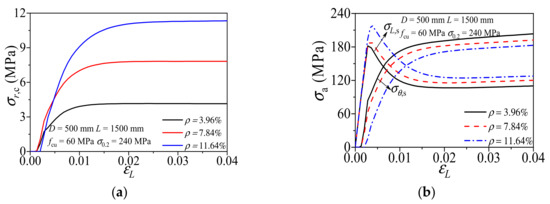
Figure 9.
Effect of aluminum ratio on composite action of CFCAT stub columns. (a) Radial stress of concrete-axial strain curves; (b) Stress of aluminum alloy–axial strain curves.
3.2.4. Elastic Modulus
The influences of elastic modulus (E0) on the composite action of CFCAT specimens is shown in Figure 10. With the same axial strain level, the specimen with higher elastic modulus has the greater concrete radial stress than the low elastic modulus counterpart. When the elastic modulus was larger, the intersection point of axial stress–axial strain curve and transverse stress–axial strain curve appeared earlier. It indicated that the greater the elastic modulus results in the stronger confinement and enhancement effect. The elastic modulus of aluminum alloy is 1/3 to the steel, thus the confinement effect of aluminum alloy tube is weaker than the steel tube.
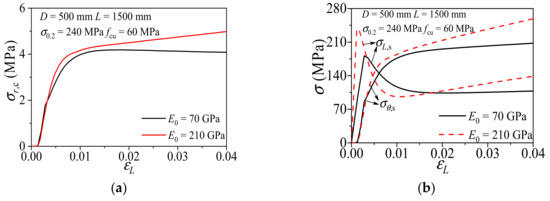
Figure 10.
Effect of elastic modulus on the composite action of CFCAT stub columns. (a) Radial stress of concrete-axial strain curves; (b) stress of aluminum alloy–axial strain curves.
4. Composite Action Model of CFCAT Stub Columns
In the analytical modeling of the axially loaded CFST stub columns, the longitudinal and transverse stress of steel tube at the limit state are the key parameters to determine the load-bearing capacity. This is because of the composite action between steel tube and infilled concrete can be theoretically derived once these parameters were obtained. However, existing studies [42,43,44,45] assume that the steel at the ultimate state of the composite columns satisfy the von Mises yield criterion:
where σl and σθ represent the longitudinal stress and transverse stress of the metal tube, respectively. This may lead inaccurate prediction due to the following reasons. Firstly, based on the FE simulation, it is found that the metal tube may yield before or after the stub column reached its ultimate state, in this situation, the Equation (6) is invalid. Moreover, the stress component along the thickness direction is neglected, which means the Equation (6) is approximate, especially when the tube wall is thick. To compensate this problem, the presented study extracts the longitudinal and the transverse stress of the aluminum alloy tube when the composite column reached its ultimate state. Since the the aluminum alloy tube was modeled by the solid element, the three-dimensional stress state is considered.
The longitudinal stress (σL,a) and the transverse stress (σθ,a) of the aluminum alloy tube at mid-height section of all the FE specimens at the ultimate state were captured. It can be found from Figure 11 that the distribution of σL,a and σθ,a highly correlated to the confinement factor ξ (ξ = σ0.2Aa/fcAc). Based on the FE analytical results, the numerical model of the composite action in CFCAT stub columns are proposed in Equations (7) and (8) using regression method. It should be noticed here that two independent formula were proposed for σL,a and σθ,a, respectively, instead of using Equation (6).
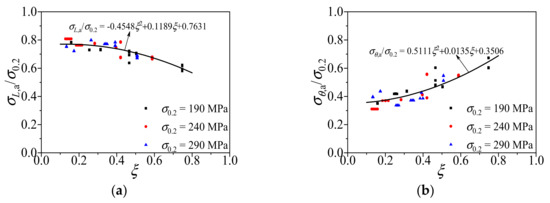
Figure 11.
The relationships between stress ratio and confinement factor. (a) Relationship between the ratio longitudinal stress to yield stress and the confinement factor; (b) relationship between the ratio transverse stress to yield stress and the confinement factor.
5. Practical Design Formula for Axial Load-Bearing Capacity of CFCAT Stub Columns
5.1. Model Simplification
The infilled concrete nephogram at mid-height section for CFCAT and CFCST stub columns at the limit state obtained by the FE analysis were compared in Figure 12. The axial stresses of the confined concrete in CFCAT and CFCST stub columns were expressed in shades of color. The figures indicate that the confinement effect occurred at the whole infilled concrete cross-section of both types of columns, and it is weaker in CFCAT stub column than that of steel tube counterparts. Based on Figure 12, the stress condition of CFCAT stub columns at limit state could be simplified as shown in Figure 13. The simplification rationally follows the stress distribution and superposition theory when the composite column reached the ultimate limit state. In the figure, D and D0 are the diameter and the inner diameter of aluminum alloy tube, respectively; Ac and Aa are the dimension of infilled concrete and aluminum alloy tube, respectively; σr,c and σθ,a is the radial stress of infilled concrete and the transverse stress of aluminum alloy tube, respectively.

Figure 12.
Comparison of stress nephogram at mid-height section for CFCAT and CFCST stub columns. (a) CFCAT stub column fcu = 40MPa (fc = 29.6 MPa); (b) CFCST stub column fcu = 40MP (fc = 29.6 MPa).
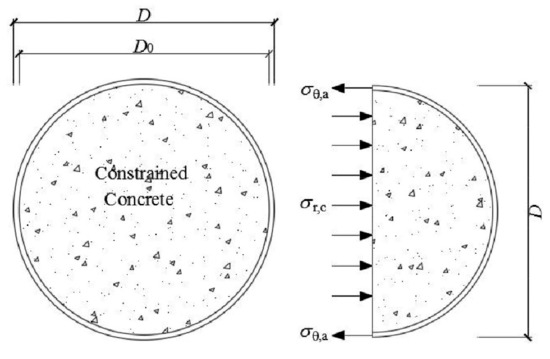
Figure 13.
Simplified stress distribution model at the mid-height section of CFCAT stub columns.
Based on the force equilibrium conditions shown in Figure 11, the following equation can be derived as:
According to the previous study about the confined concrete [46], the relationship of axial stress and the radial stress considering the confinement effect of infilled concrete can be expressed as:
5.2. Derivation of Design Formula of CFCAT Stub Columns
According to the static equilibrium condition of cross-section, the ultimate bearing capacity of CFCAT stub columns can be expressed as:
Substituting Equations (7)–(11) into Equation (12), the ultimate bearing capacity (Nu1) of CFAST stub columns can be expressed as:
To simplify the calculation process, the average ratio of σL,a – σ0.2 and σθ,a – σ0.2 can be employed instead of the Equations (7) and (8). Figure 14 shows the calculated relationships between the σL,a–σ0.2 ratio, σθ,a–σ0.2 ratio and the specimen’s ultimate strength. For CFCAT stub columns, the average ratio of σL,a–σ0.2 was 0.74, greater than 0.69 of the CFCST stub columns; the average ratio of σθ,a–σ0.2 was 0.43, smaller than 0.55 of the CFCST stub columns [32]. The relationship between σL,a–σ0.2 and σθ,a–σ0.2 can be taken as:

Figure 14.
Axial stress and transverse stress of CFCAT stub columns. (a) Average ratio of longitudinal stress to yield stress; (b) average ratio of transverse stress to yield stress.
Substituting Equations (9)–(11) and Equations (14) and (15) into Equation (12), the ultimate axial bearing capacity (Nu2) can be derived as:
where K is the enhancement factor [47] which reflects the enhancement effect provided by the infilled concrete to the outer tube. For CFCAT stub columns, K is 1.47, which is lower than 1.62 of CFCST stub columns [32].
5.3. Formula Validation
The ultimate bearing capacities calculated from Equation (15) (Nu1) and Equation (18) (Nu2) were compared with collected test results (Nu,exp) and previously performed FE analysis results (Nu,FE), as shown in Figure 15. The average ratios of Nu,exp to Nu1 and Nu2 are 1.004 and 0.991 with the dispersion coefficients of 0.049 and 0.055, respectively. The consequences of Equations (15) and (18) showed that there is nearly no difference using these two formulas to calculate the ultimate bearing capacity of the CFCAT stub columns. The Equation (18) has a relatively safe calculation result and the simple form, which is beneficial to the application in practical engineering.
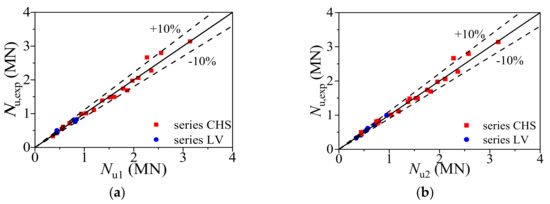
Figure 15.
Comparison of ultimate bearing capacity. (a) Comparison of the ultimate bearing capacities obtained from test results and Equation (15; (b) comparison of the ultimate bearing capacities obtained from test results and Equation (18).
Table 3 showed the formulas of axial bearing capacity provided by different well-known design codes. The results obtained from those formulas are compared with test results in Table 4. The average ratio of Nu,exp to Nu3, Nu4, Nu5 and Nu6 is 0.799, 0.986, 0.921 and 0.864 with the corresponding dispersion coefficient of 0.061, 0.077, 0.056 and 0.076, respectively. The ultimate bearing capacities calculated from Equation (17) (Nu4) to Equation (20) (Nu6) were compared with collected test results (Nu,exp), as shown in Figure 16. As a result, the proposed formula (Equation (12)) has higher accuracy in predicting the axial bearing capacity of CFCAT stub columns.

Table 3.
Summary of available formulas in well-known national codes.

Table 4.
Comparison between experimental and predicted result using different design methods.
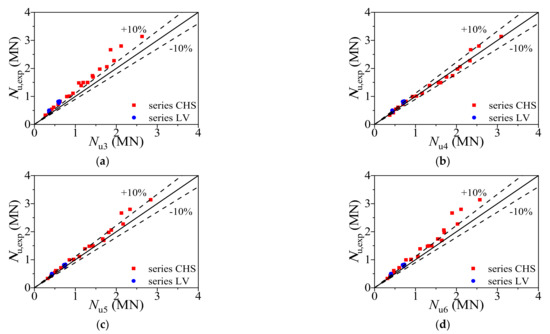
Figure 16.
Comparison of ultimate bearing capacity. (a) Comparison of the ultimate bearing capacities obtained from test results and Equation (19); (b) comparison of the ultimate bearing capacities obtained from test results and Equation (20); (c) comparison of the ultimate bearing capacities obtained from test results and Equation (21); (d) comparison of the ultimate bearing capacities obtained from test results and Equation (22).
6. Conclusions
This paper investigated the confinement effects of the CFCAT stub columns under axial compression. The main contents and conclusions are as follows:
- A fine-meshed finite 3D solid element model of CFCAT under axial compression was established based on the tri-axial plastic-damage constitutive model of concrete and elastoplastic constitutive model of the aluminum alloy. The FE analytical results coincide well with the experimental results.
- Based on the validated FE modeling technique, 90 full-scale FE models were established for parametric study. The numerical results revealed that the higher aluminum alloy strength and ratio lead to a better confinement effect and a weakened enhancement effect. As a result, the compatibility of the strength and dimension of the aluminum alloy and concrete should be noticed in the design, rather than only seeking better confinement.
- Regression models of the longitudinal stress and transverse stress of the aluminum alloy tube at the ultimate state of the columns were proposed, respectively. This model considered the three-dimensional stress state of the outer tube and is a more authentic expression when the column reached its ultimate state.
- A design formula was proposed to estimate the ultimate bearing capacity of CFCAT stub columns under axial compression. An enhancement factor which reflects the level of composite action of CFCAT stub columns is calculated. The obtained value of 1.47, which is smaller than the confinement coefficient of 1.62 of CFCST stub columns. The proposed formula that was evaluated has a higher accuracy compared with some current design methods.
Author Contributions
Conceptualization, F.D., E.W. and F.L.; methodology, F.D., E.W. and F.L.; software, C.L., E.W., Y.F. and Z.S.; validation, E.W.; formal analysis, E.W., Y.X. and Y.L.; investigation, E.W., Y.X. and Y.L.; resources, E.W.; data curation, E.W., Y.X., Y.L., Y.F. and Z.S.; writing—original draft preparation, F.D., C.L., E.W. and F.L.; writing—review and editing, E.W., F.L., Y.F. and Z.S.; visualization, E.W.; supervision, F.D.; project administration, F.D.; funding acquisition, F.D. All authors have read and agreed to the published version of the manuscript.
Funding
This research was funded by the National Natural Science Foundation of China (Grant No. 51978664). Science Fund for Distinguished Young Scholars in Hunan Province (Grant No. 2019JJ20029). National Natural Science Foundation of China (Grant No. 52008400).
Institutional Review Board Statement
Not applicable.
Informed Consent Statement
Not applicable.
Data Availability Statement
No new data were created or analyzed in this study. Data sharing is not applicable to this article.
Conflicts of Interest
The authors declared that they have no conflict of interest to this work. We declare that we do not have any commercial or associative interest that represents a conflict of interest in connection with the work submitted.
References
- Shen, Z.Y.; Guo, X.N.; Li, Y.Q. State of the arts of research on aluminium alloy structures. J. Build. Struct. 2007, 28, 100–109. [Google Scholar]
- Das, S. Development of aluminium alloy composites for engineering applications. Trans. Indian Inst. Met. 2004, 57, 325–334. [Google Scholar]
- Blatnický, M.; Sága, M.; Dižo, J.; Bruna, M. Application of Light Metal Alloy EN AW 6063 to Vehicle Frame Construction with an Innovated Steering Mechanism. Materials 2020, 13, 817. [Google Scholar] [CrossRef] [PubMed]
- Chen, Y.; Feng, R.; Gong, W. Flexural behavior of concrete-filled aluminum alloy circular hollow section tubes. Constr. Build. Mater. 2018, 165, 173–186. [Google Scholar] [CrossRef]
- Szumigała, M.; Polus, Ł. Applications of Aluminium and Concrete Composite Structures. Procedia Eng. 2015, 108, 544–549. [Google Scholar] [CrossRef]
- Zhou, F.; Young, B. Tests of concrete-filled aluminum stub columns. Thin-Walled Struct. 2008, 46, 573–583. [Google Scholar] [CrossRef]
- Zhou, F.; Young, B. Concrete-filled aluminum circular hollow section column tests. Thin-Walled Struct. 2009, 47, 1272–1280. [Google Scholar] [CrossRef]
- Zhou, F.; Young, B. Concrete-filled double-skin aluminum circular hollow section stub columns. Thin-Walled Struct. 2018, 133, 141–152. [Google Scholar] [CrossRef]
- Zhu, J.-H.; Young, B. Experimental investigation of aluminum alloy circular hollow section columns. Eng. Struct. 2006, 28, 207–215. [Google Scholar] [CrossRef]
- Ramberg, W.; Osgood, W.R. Description of Stress-Strain Curves by Three Parameter. Technical Notes No. 902. 1943. Available online: https://ntrs.nasa.gov/citations/19930081614 (accessed on 20 April 2021).
- Ding, F.X.; Wang, W.J.; Liu, X.M.; Wang, L.P.; Sun, Y. Mechanical behavior of outer square inner circular concrete filled dual steel tubular stub columns. Steel Compos. Struct. 2021, 38, 305–317. [Google Scholar] [CrossRef]
- Lu, D.-R.; Wang, W.-J.; Ding, F.-X.; Liu, X.-M.; Fang, C.-J. The impact of stirrups on the composite action of concrete-filled steel tubular stub columns under axial loading. Structures 2021, 30, 786–802. [Google Scholar] [CrossRef]
- Wang, Y.; Yang, Y.; Zhang, S. Static behaviors of reinforcement-stiffened square concrete-filled steel tubular columns. Thin-Walled Struct. 2012, 58, 18–31. [Google Scholar] [CrossRef]
- Qu, X.; Chen, Z.; Sun, G. Axial behaviour of rectangular concrete-filled cold-formed steel tubular columns with different loading methods. Steel Compos. Struct. 2015, 18, 71–90. [Google Scholar] [CrossRef]
- Nasser, K.Z. Structural Behavior of Concrete Filled Aluminum Tubular Columns. Basrah J. Eng. Sci. 2012, 12, 46–59. [Google Scholar]
- Resan, F. Experimental Investigation of Aluminium-Lightweight Concrete Composite Columns. Basrah J. Eng. Sci. 2014, 14, 13–25. [Google Scholar]
- Aluminium Association. Aluminium Design Manual—Part I: Specification for Aluminium Structures; Aluminium Association: Washington, DC, USA, 2005. [Google Scholar]
- ACI. ACI 318-08: Building Code Requirements for Structural Concrete and Commentary; American Concrete Institute: Detroit, MI, USA, 2008. [Google Scholar]
- Australia/New Zealand Strandard. Aluminium Structures Part 1: Limit State Design; AS/NZS 1664.1-1997; Standards Australia: Sydney, NSW, Australia, 1997.
- Australian Standard AS3600. Concrete Structures; AS3600-2001; Standards Australia: Sydney, NSW, Australia, 2001. [Google Scholar]
- Zhou, F.; Young, B. Numerical analysis and design of concrete-filled aluminum circular hollow section columns. Thin-Walled Struct. 2012, 50, 45–55. [Google Scholar] [CrossRef]
- Wang, F.-C.; Zhao, H.-Y.; Han, L.-H. Analytical behavior of concrete-filled aluminum tubular stub columns under axial compression. Thin-Walled Struct. 2019, 140, 21–30. [Google Scholar] [CrossRef]
- Hibbitt, B.K.D.; Sorensen, P. ABAQUS Standard User’s and Reference Manuals; Version 6.14; Dassault Systèmes: Providence, RI, USA, 2014. [Google Scholar]
- Wang, F.C.; Zhao, H.Y.; Han, L.H. Analytical Behavior of Concrete-Filled Aluminum Tubular Stub Columns Under Axial Compression. In Proceedings of the 12th International Conference on Advances in Steel-Concrete Composite Structures—ASCCS 2018, Valencia, Spain, 27–29 June 2018. [Google Scholar]
- Idan, F.K. Finite element analysis of concrete-filled aluminium tube columns. Int. J. Appl. Eng. Res. 2017, 12, 3054–3062. [Google Scholar]
- Patel, V.I.; Liang, Q.Q.; Hadi, M.N. Numerical study of circular double-skin concrete-filled aluminum tubular stub columns. Eng. Struct. 2019, 197, 109418. [Google Scholar] [CrossRef]
- Liu, Y.; Lyu, F.; Ding, F.; Wang, E.; Xu, Y.; Yuan, T.; Deng, C.; Luo, C. Numerical Study on Confinement Effect and Efficiency of Concentrically Loaded RACFRST Stub Columns. Front. Mater. 2021, 8. [Google Scholar] [CrossRef]
- Bencardino, F.; Nisticò, M.; Verre, S. Experimental Investigation and Numerical Analysis of Bond Behavior in SRG-Strengthened Masonry Prisms Using UHTSS and Stainless-Steel Fibers. Fibers 2020, 8, 8. [Google Scholar] [CrossRef]
- Fortunato, G.; Funari, M.F.; Lonetti, P. Survey and seismic vulnerability assessment of the Baptistery of San Giovanni in Tumba (Italy). J. Cult. Herit. 2017, 26, 64–78. [Google Scholar] [CrossRef]
- Ding, F.; Ying, X.; Zhou, L.; Yu, Z. Unified calculation method and its application in determining the uniaxial mechanical properties of concrete. Front. Arch. Civ. Eng. China 2011, 5, 381–393. [Google Scholar] [CrossRef]
- Jankowiak, T.; Lodygowski, T. Identification of parameters of concrete damage plasticity constitutive model. Found. Civ. Environ. Eng. 2005, 6, 53–69. [Google Scholar]
- Ding, F.-X.; Yin, Y.-X.; Mao, J.-F.; Wang, L.-P.; Yu, Y.-J.; Luo, L.; Yu, Z.-W. Analytical behaviors of concrete-filled circular stainless steel tubular (CFCSST) stub columns under axial loading. Structures 2019, 19, 277–285. [Google Scholar] [CrossRef]
- Chen, Z.Y.; Zhu, J.Q.; Wu, P.G. High-Strength Concrete and its Applications; Tsinghua University Press: Beijing, China, 1992. [Google Scholar]
- Gardner, L.; Ashraf, M. Structural design for non-linear metallic materials. Eng. Struct. 2006, 28, 926–934. [Google Scholar] [CrossRef]
- EU. Eurocode 9 (EC9) EN 1999-1-1:2007, Design of Aluminium Structures-General Structure Rules. In Edict of Government; CEN: Brussels, Belgium, 2013. [Google Scholar]
- Wang, F.-C.; Han, L.-H.; Li, W. Analytical behavior of CFDST stub columns with external stainless steel tubes under axial compression. Thin-Walled Struct. 2018, 127, 756–768. [Google Scholar] [CrossRef]
- Ashraf, M.; Gardner, L.; Nethercot, D.A. Finite element modelling of structural stainless steel cross-sections. Thin-Walled Struct. 2006, 44, 1048–1062. [Google Scholar] [CrossRef]
- Gardner, L.; Nethercot, D.A. Numerical Modeling of Stainless Steel Structural Components—A Consistent Approach. J. Struct. Eng. 2004, 130, 1586–1601. [Google Scholar] [CrossRef]
- Ellobody, E.; Young, B. Structural performance of cold-formed high strength stainless steel columns. J. Constr. Steel Res. 2005, 61, 1631–1649. [Google Scholar] [CrossRef]
- Tao, Z.; Uy, B.; Liao, F.-Y.; Han, L.-H. Nonlinear analysis of concrete-filled square stainless steel stub columns under axial compression. J. Constr. Steel Res. 2011, 67, 1719–1732. [Google Scholar] [CrossRef]
- Gong, Y.L. Experimental and Theoretical Research on Mechanical Property of Common Concrete Filled Metal Tubes Columns; Harbin Institute of Technology: Harbin, China, 2011. [Google Scholar]
- Sakino, K.; Nakahara, H.; Morino, S.; Nishiyama, I. Behavior of Centrally Loaded Concrete-Filled Steel-Tube Short Columns. J. Struct. Eng. 2004, 130, 180–188. [Google Scholar] [CrossRef]
- Hatzigeorgiou, G.D. Numerical model for the behavior and capacity of circular CFT columns, Part I: Theory. Eng. Struct. 2008, 30, 1573–1578. [Google Scholar] [CrossRef]
- Liu, J.; Zhang, S.; Zhang, X.; Guo, L. Behavior and strength of circular tube confined reinforced-concrete (CTRC) columns. J. Constr. Steel Res. 2009, 65, 1447–1458. [Google Scholar] [CrossRef]
- Mei, H.; Kiousis, P.D.; Ehsani, M.R.; Saadatmanesh, H. Confinement effects on highstrength concrete. Struct. J. 2001, 98, 548–553. [Google Scholar]
- Ding, F.-X.; Yu, Z.-W.; Bai, Y.; Gong, Y.-Z. Elasto-plastic analysis of circular concrete-filled steel tube stub columns. J. Constr. Steel Res. 2011, 67, 1567–1577. [Google Scholar] [CrossRef]
- Wei, Y.; Jiang, C.; Wu, Y.-F. Confinement effectiveness of circular concrete-filled steel tubular columns under axial compression. J. Constr. Steel Res. 2019, 158, 15–27. [Google Scholar] [CrossRef]
- Zha, X.X.; Gong, Y.L. Behavior study of new-type concrete filled metal tubular (CFMT) columns Ⅰ: Strength capacity of axially compressed short columns. Prog. Steel Build. Struct. 2012, 14, 12–18. [Google Scholar]
Publisher’s Note: MDPI stays neutral with regard to jurisdictional claims in published maps and institutional affiliations. |
© 2021 by the authors. Licensee MDPI, Basel, Switzerland. This article is an open access article distributed under the terms and conditions of the Creative Commons Attribution (CC BY) license (https://creativecommons.org/licenses/by/4.0/).